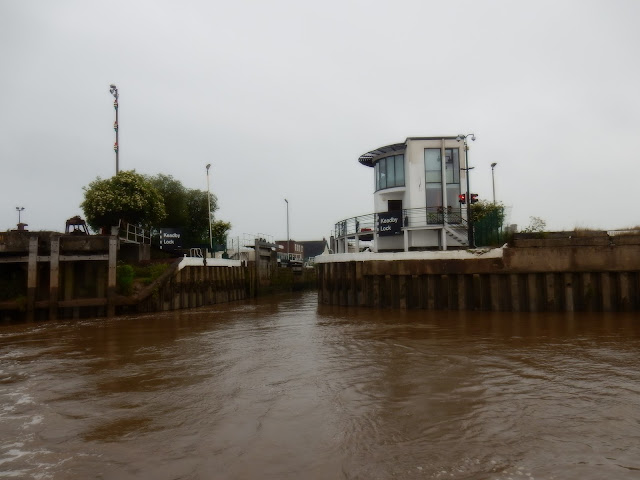The last blog found us heading up the River Hull and half way through the thirteen bridges that span the river within the city. I was nervous about the timing of the trip as we had to be able to pass under the last bridge otherwise we would be stuck.
The next bridge we came to was also the oldest. Sculcoates Bridge was opened in 1874. The 56ft span is crossed by the cast iron girder bridge which is counterbalanced over the land side. There is the short fixed span too.
The next bridge is the only rail bridge that now crosses the River Hull. It was built to replace an earlier bridge in 1907 by the North Eastern Railway. The railway closed in 1968 but it is still in uses as a footpath and cycle way. You can also see the British Extracting Co Limited Mill in Wilmington that was designed by well known Hull firm of architects, Gelder and Kitchen and erected in 1919. It has some nice Baroque revival details in the 6+ stories. It was built to receive grains from river and road in collecting store and then placed in the silos ready for use. The soya, flax, cotton and rape seeds came from home and abroad and the big extracting industry that started up in Hull led to other industries like paint and machinery.
This bow string Wilmington swing bridge was built for the North East Railway in 1907 and still carries freight trains that eventually connect up with the eastern docks after a circitous route round the north of Hull.
As you can see the river level is coing up and the air draft is reducing. There was plenty of room to slip under the pair of Stoneferry that were opened in 1991, replacing a swing bridge erected in 1907. Before that there was said to be a ford here. One bridge carries a carriageway each.
Apparently the machinery and control room are neo- Georgian and the Sutton Road Bridge is a Scherzer rolling or walking bridge was opened in 1939 and looks very sturdy indeed. As you can see there is still plenty of room under this bridge.
The Ennerdal Ling bridges were built in 1997 by the same builder as the Stoneferry bridges, and hence they look similar. They were needed when a planned partly built tunnel flooded. The air draft on a rising tide is crucial here as these are the lowest we have to pass under before high water. As you can see there is less room here, and I reckon I had another 30 mins before it was getting a bit dodgy.
Once through the Ennerdale Bridges we could relax and slow down a little to try and arrive at the Beverley nearer to high water. There had to be plenty of water to get over the sill, but with just 2 ft draft I don't think we need worry about that. We made it in the sun and after a little poke about we worked out how to make everything work. We had been given the combinations of the locks on the paddle wheels and even remembered to take the pin out connecting the two inner gates.
After a few days down on the Beverley Beck, with electricity, and plenty of visitors, we decided to continue our exploration of the River Hull and see how far we could get towards the original terminus at Driffield. The first obstacle would have been the Grovehill Bridge that was opened in 1953. We would have had to leave the lock as soon as possible to fit under the bridge but luckily the barge 'Syntan' was going on a jolly up river and would need the bridge lifting so we could tag on behind. The bridge replaced a ferry bridge. The area was the site of Cook, Welton and Gemmel ship yard that built tugs and trawlers in abundance.
Almost he last two bridges on our trip are at Tickton. The first is the foot bridge that was erected in 1976 replacing a rolling bridge built in 1913 and through the span is the Tickton by-pass road bridge that is a standard concrete bridge built in 1974.
The head of the tidal limit is at Struncheon Lock, where there is also a weir alongside. The lock was built between 1803 and 1811 to Yorkshire keel size. The lock gear requires special windlasses to work them and we had been kindly lent them by the Beverley Barge Preservation Society. The 'Syntan' winded above the lock so we were on our own from here.
Above the lock the route become the Driffield Navigation, rather than the River Hull, and the next navigational problem is Bethell's Bridge. The original bridge was built at the same time as Struncheon Lock as the new cut and removed a series of meanders of the river, but access was still required. There is a fixed section and a swing portion. By the late 1960's lack of maintenance meant it had jammed shut, plus damage from overweight lorries. The local framers needed access and so they did the work themselves along with other members of the Driffield Navigation Amenities Association. It was restored in the late 1970's and has been maintained in working condition since, if somewhat rudimentary.
We got as far as North Frodingham Wharf as after there there is nowhere for a 58'9" boat to wind. The navigation to Driffield is all but complete. The onky stumbling block to getting our boat to the river head is the low bridge that had become fixed and presently there is a problem with the riparian owner of the area so things are on hold. At least I think that is the problem. Above is the Struncheon Hill Lock on the way back down to Beverley on the way down. It was a great trip up and Beverley is certainly work the visit.





















































